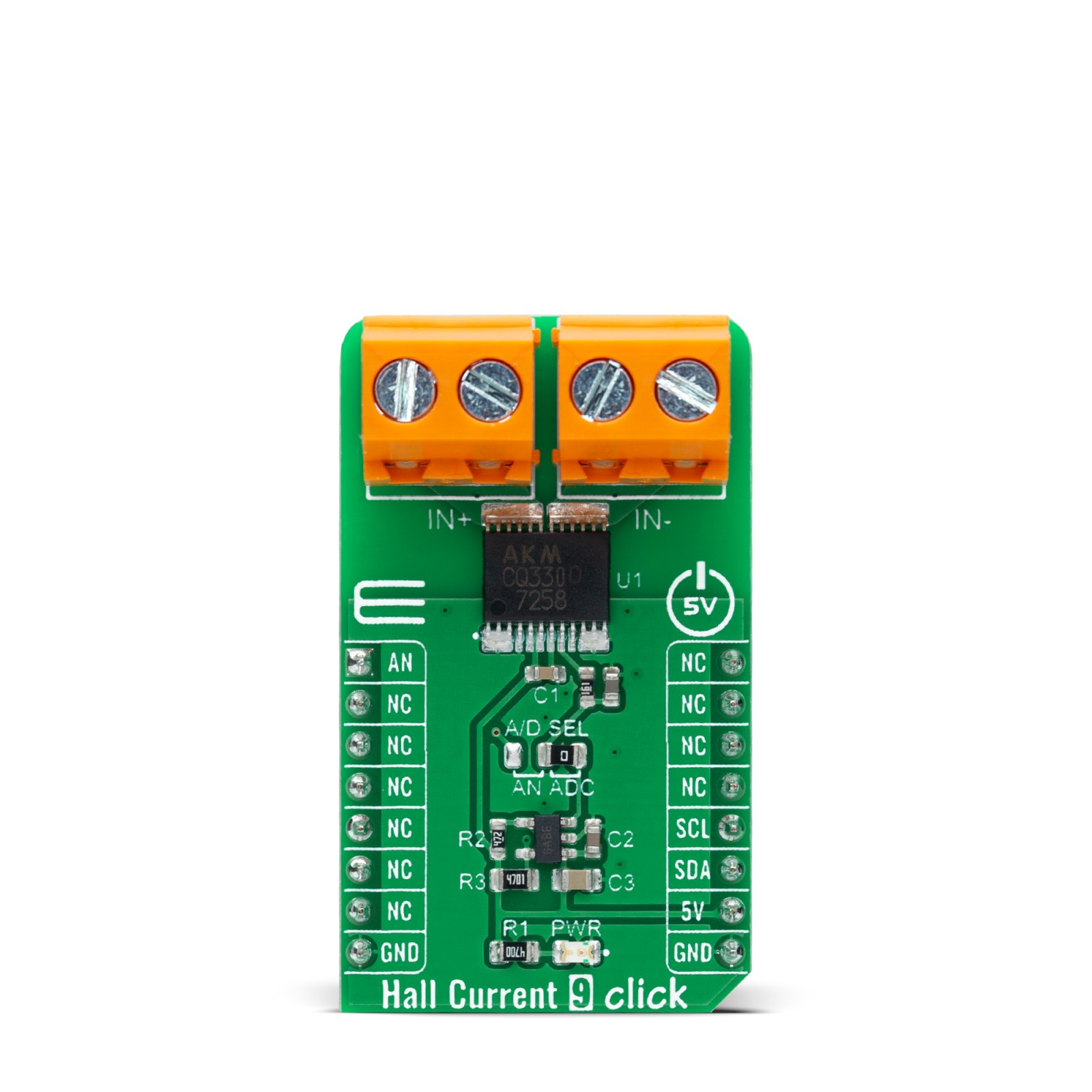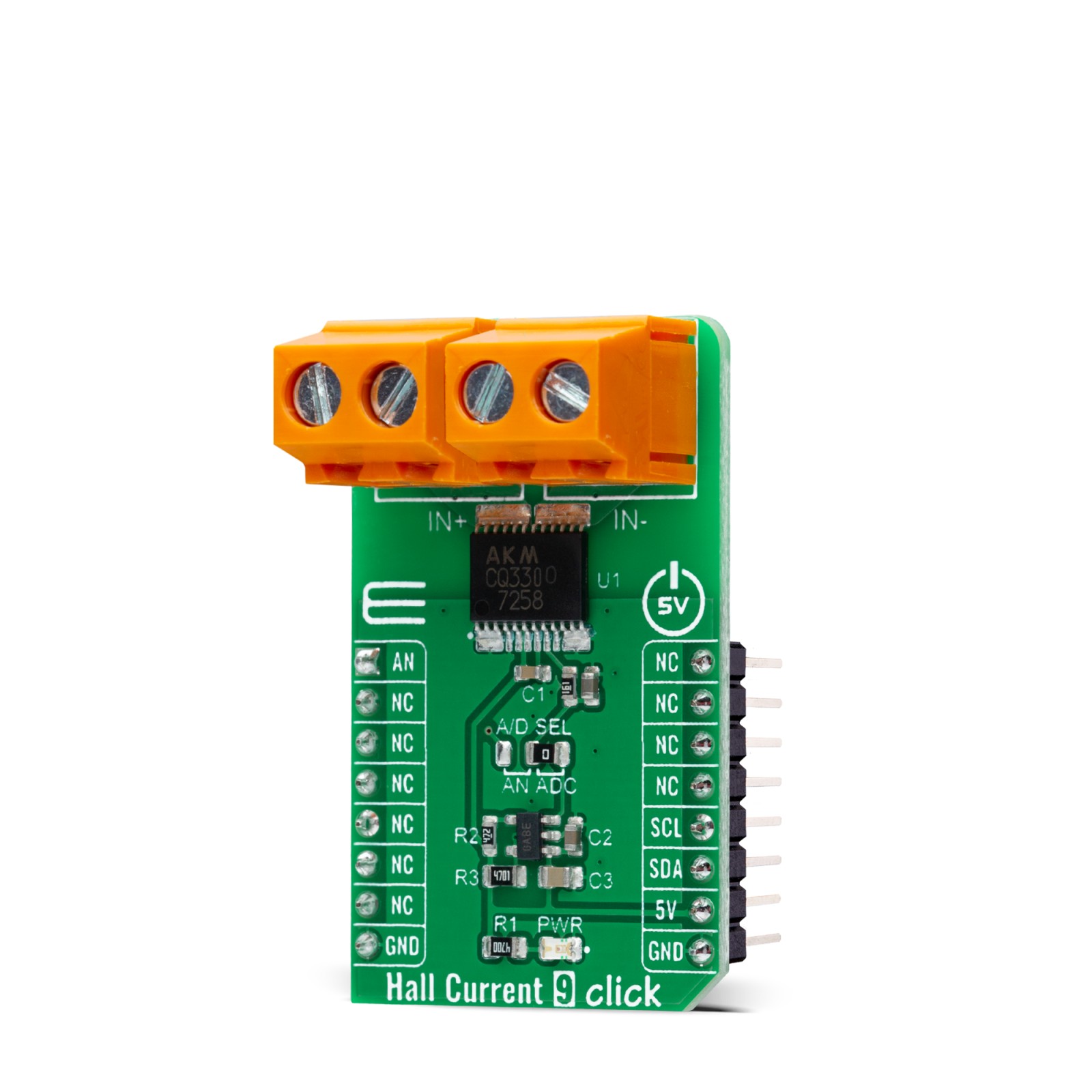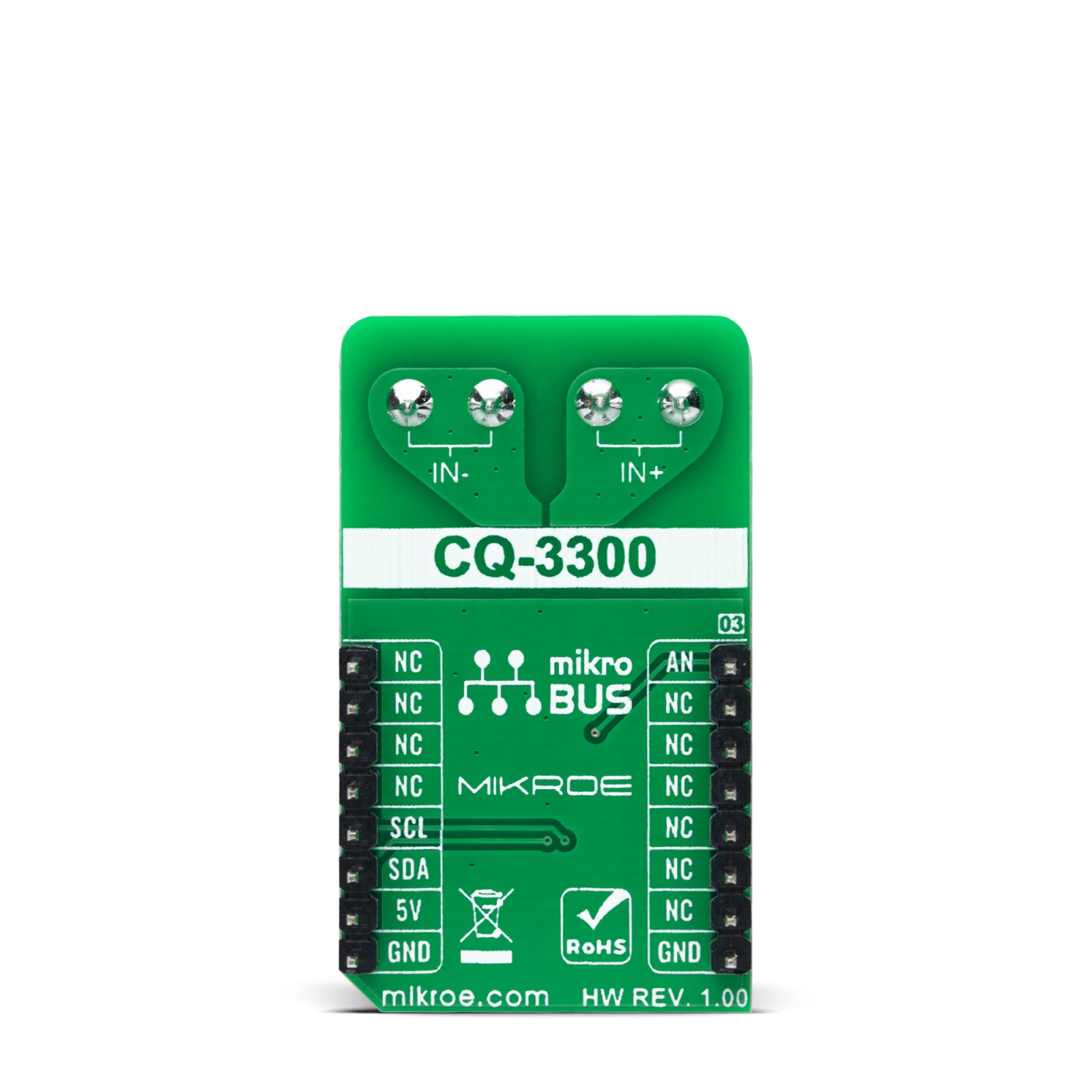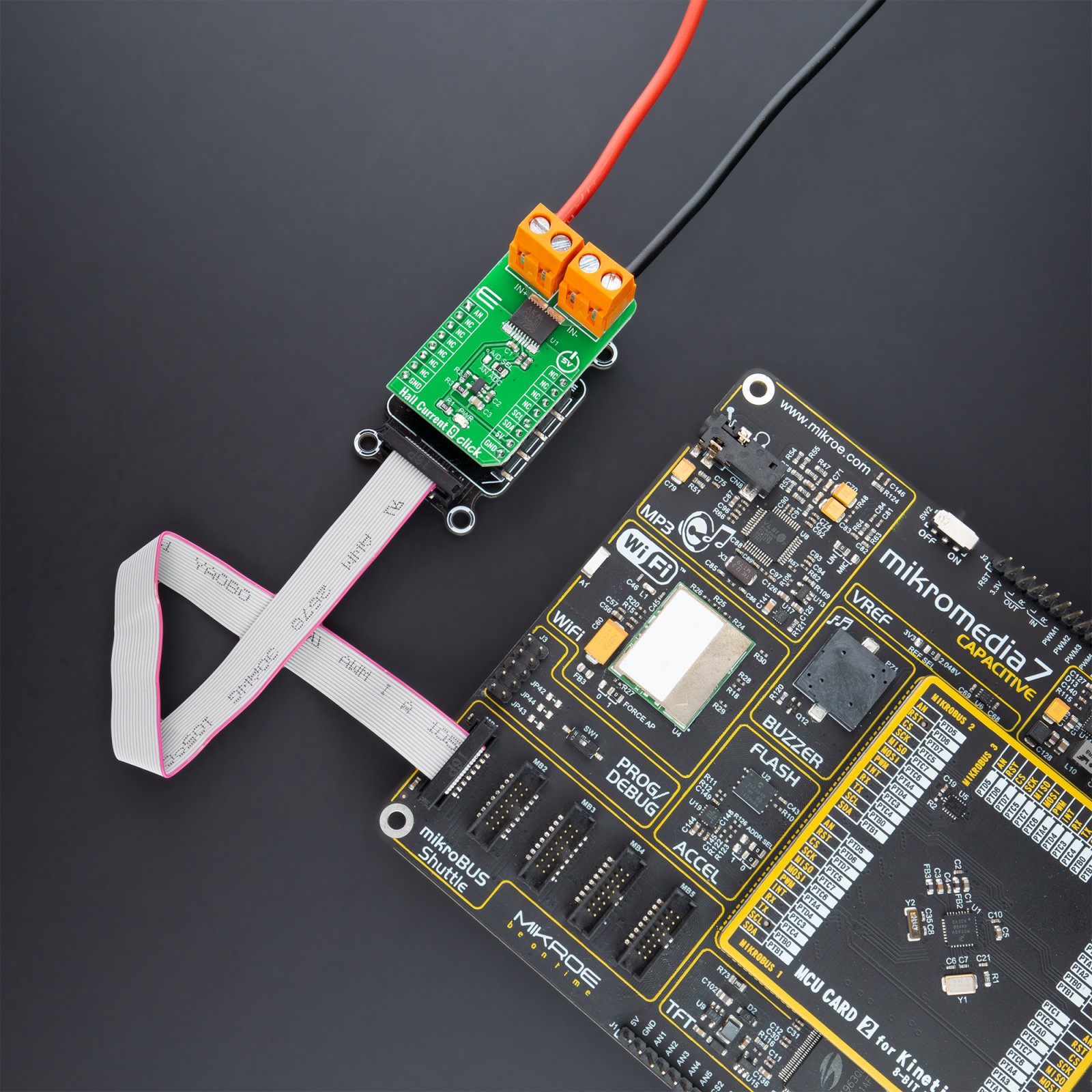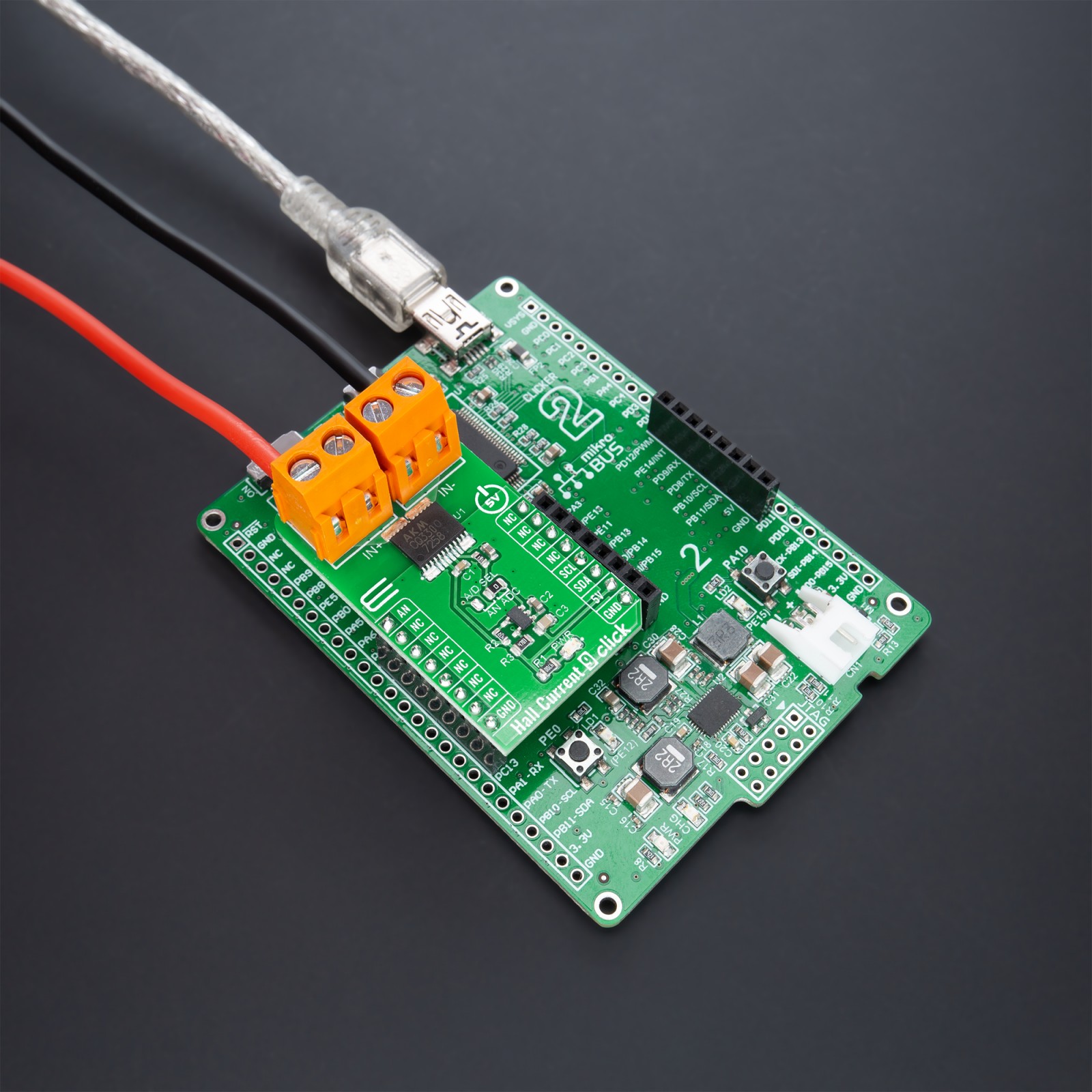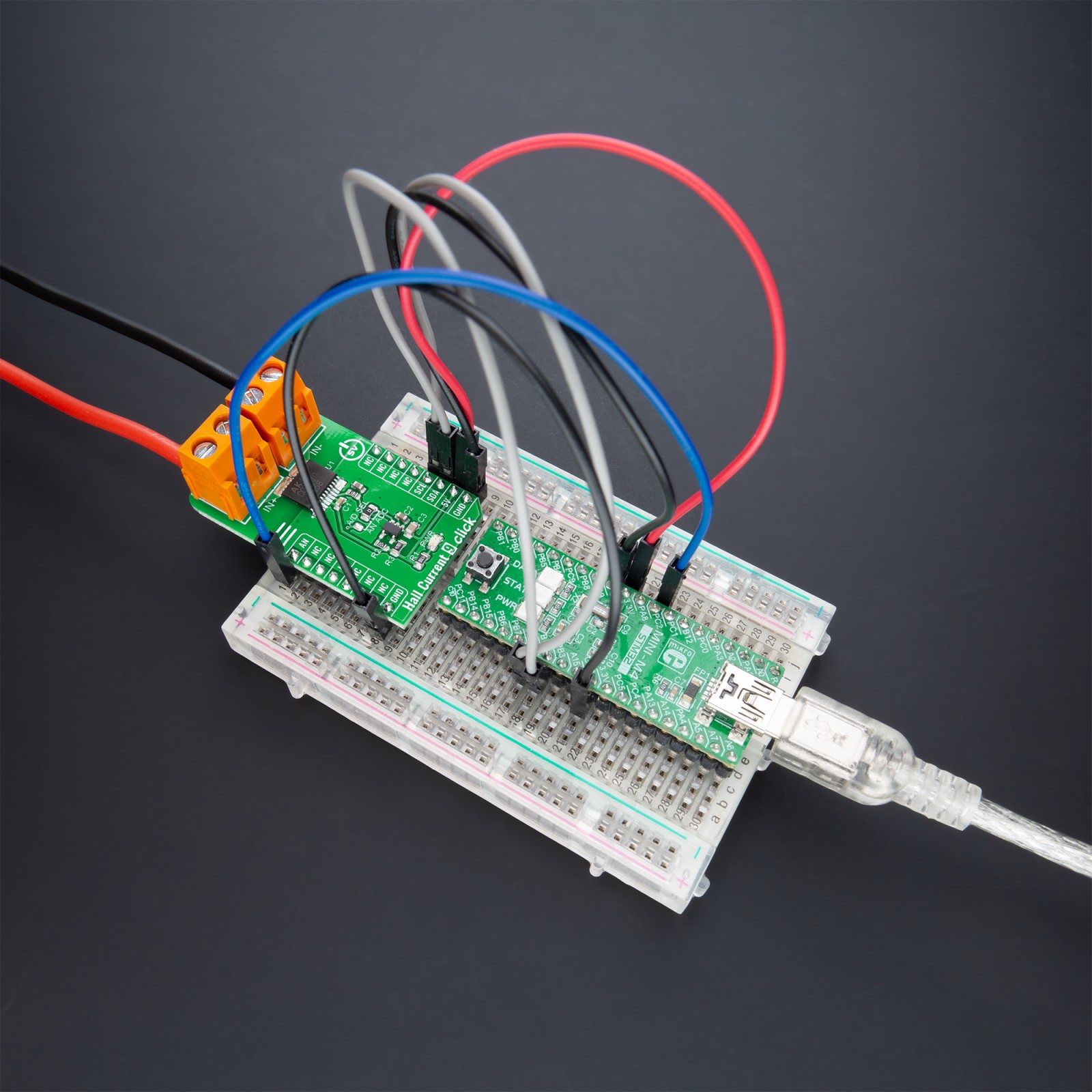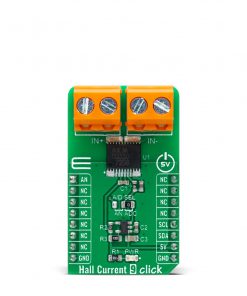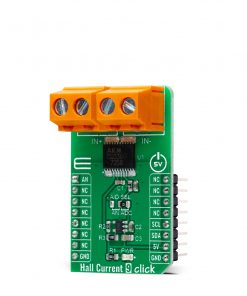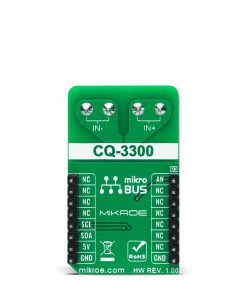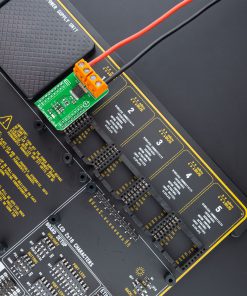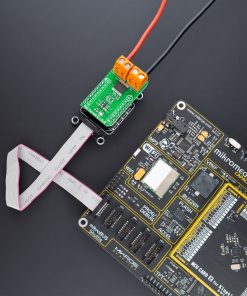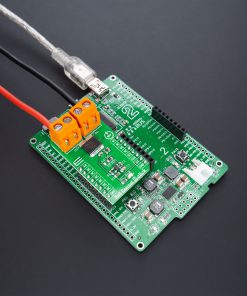Hall Current 9 Click
R540.00 ex. VAT
Hall Current 9 Click is a compact add-on board that provides a fast and precise solution for AC / DC current sensing. This board features the CQ3300, a high-speed response coreless current sensor using a Hall sensor that outputs the analog voltage proportional to the AC/DC from AKM Semiconductor. It employs a high sensitive InAs (Indium Arsenide) Hall element with the ability to detect both DC and AC with high accuracy and high speed. It has an ultra-fast high response of 0.5μsec, high galvanic isolation, and it is designed for the currents to range from -6.4A to +6.4A. This Click board™ is suitable for overcurrent applications and shows good performance in small-sized inverter applications.
Hall Current 9 Click is supported by a mikroSDK compliant library, which includes functions that simplify software development. This Click board™ comes as a fully tested product, ready to be used on a system equipped with the mikroBUS™ socket.
Stock: Lead-time applicable.
| 5+ | R513.00 |
| 10+ | R486.00 |
| 15+ | R459.00 |
| 20+ | R441.72 |
 DO NOT TOUCH THE BOARD WHILE THE EXTERNAL POWER SUPPLY IS ON!
DO NOT TOUCH THE BOARD WHILE THE EXTERNAL POWER SUPPLY IS ON!
Note: The Click board™ is to be used by trained personnel only, while applying high voltages. A special care should be taken when working with hazardous voltage levels.
How does it work?
Hall Current 9 Click is based on the CQ3300, a high-speed response coreless current sensor using a Hall sensor that outputs the analog voltage proportional to the AC/DC from AKM Semiconductor. This current sensor has a small-size and high galvanic isolation, specially designed for the currents range from -6.4A to +6.4A. Quantum well ultra-thin film of Indium Arsenide is used as the Hall sensor, which enables the high-accuracy and high-speed current sensing showing good performance in small-sized inverter application. It has primary conductor resistance that reduces the heat generated by current significantly compared to a shunt resistor allowing a continuous current flow of 20Arms and has an ultra-fast high response of 0.5μs, making it also suitable for overcurrent applications.
.jpg)
The internal structure of the CQ3300 consists of several blocks such as primary conductor, Hall sensor, amplifier, buffer, compensation block, bias, and EEPROM unit. The primary conductor measure applied current, while the Hall element detects magnetic flux density generated from the measured current. Hall element’s output is then amplified, with a compensation circuit that adjusts the temperature drifts of sensitivity and zero-current output voltage. The last block is the output buffer with gain that outputs the voltage proportional to the current applied to the primary conductor.
The CQ3300 has a ratiometric output that means it changes proportionally to the supply voltage. It is suitable for applications where the analog output is converted to digital using an A/D converter and where fluctuation of the power supply voltage causes reference error of the A/D converter. Just like that, the output voltage can be converted to a digital value using MCP3221, a successive approximation A/D converter with a 12-bit resolution from Microchip, using a 2-wire I2C compatible interface, or can be sent directly to an analog pin of the mikroBUS™ socket labeled as AN. Selection can be performed by onboard SMD jumper labeled as A/D SEL to an appropriate position marked as AN and ADC.
The MCP3221 provides one single-ended input with very low-power consumption, a low maximum conversion current, and a Standby current of 250 μA and 1 μA, respectively. Data can be transferred at rates of up to 100 kbit/s in the Standard and up to 400 kbit/s in the Fast Mode. Also, maximum sample rates of 22.3 kSPS with the MCP3221 are possible in a Continuous-Conversion Mode with a clock rate of 400 kHz.
This Click board™ is designed to be operated only with a 5V logic voltage level. A proper logic voltage level conversion should be performed before the Click board™ is used with MCUs with different logic levels. However, the Click board™ comes equipped with a library that contains functions and an example code that can be used, as a reference, for further development.
Specifications
Type
Current sensor,Measurements
Applications
Can be used for overcurrent applications and shows good performance in small-sized inverter applications.
On-board modules
CQ3300 – high-speed response coreless current sensor using a Hall sensor that outputs the analog voltage proportional to the AC/DC from AKM Semiconductor
MCP3221 – successive approximation A/D converter with a 12-bit resolution from Microchip
Key Features
Low power consumption, high precission, highly sensitive quantum well structure InAs Hall element, characterized by the ability to detect both DC and AC with high accuracy and high speed, and more.
Interface
Analog,I2C
Feature
No ClickID
Compatibility
mikroBUS™
Click board size
M (42.9 x 25.4 mm)
Input Voltage
5V
Pinout diagram
This table shows how the pinout on Hall Current 9 Click corresponds to the pinout on the mikroBUS™ socket (the latter shown in the two middle columns).
Onboard settings and indicators
| Label | Name | Default | Description |
|---|---|---|---|
| LD1 | PWR | – | Power LED Indicator |
| JP1 | A/D SEL | Right | Output Voltage A/D Selection AN/ADC: Left position AN, Right position ADC |
Hall Current 9 Click electrical specifications
| Description | Min | Typ | Max | Unit |
|---|---|---|---|---|
| Supply Voltage | – | 5 | – | V |
| Analog Output Current | -0.5 | – | 0.5 | mA |
| Primary Current | -6.4 | – | +6.4 | A |
| Sensitivity | – | 195 | – | mV/A |
| Total Accuracy | – | ±1.3 | – | %F.S |
| Response Time | – | 0.5 | – | μs |
| Operating Temperature Range | -40 | +25 | +90 | °C |
Software Support
We provide a library for the Hall Current 9 Click as well as a demo application (example), developed using MikroElektronika compilers. The demo can run on all the main MikroElektronika development boards.
Package can be downloaded/installed directly from NECTO Studio Package Manager(recommended way), downloaded from our LibStock™ or found on mikroE github account.
Library Description
This library contains API for Hall Current 9 Click driver.
Key functions:
void hallcurrent9_cfg_setup ( hallcurrent9_cfg_t *cfg );– Config Object Initialization function.HALLCURRENT9_RETVAL hallcurrent9_init ( hallcurrent9_t *ctx, hallcurrent9_cfg_t *cfg );– Initialization function.void hallcurrent9_default_cfg ( hallcurrent9_t *ctx );– Click Default Configuration function.
Examples description
The demo application reads ADC value and current value.
The demo application is composed of two sections :
void application_task ( void ) {
log_printf( &logger, "--------------------------rn", adc_data );
hallcurrent9_read_adc( &hallcurrent9, &adc_data );
log_printf( &logger, " ADC : %d rn", adc_data );
current = hallcurrent9_get_current( &hallcurrent9, current_offset, calc_fact );
log_printf( &logger, " Current : %.2f mA rn", current );
Delay_ms( 2000 );
}
The full application code, and ready to use projects can be installed directly from NECTO Studio Package Manager(recommended way), downloaded from our LibStock™ or found on mikroE github account.
Other mikroE Libraries used in the example:
- MikroSDK.Board
- MikroSDK.Log
- Click.HallCurrent9
Additional notes and informations
Depending on the development board you are using, you may need USB UART click, USB UART 2 click or RS232 click to connect to your PC, for development systems with no UART to USB interface available on the board. The terminal available in all MikroElektronika compilers, or any other terminal application of your choice, can be used to read the message.
mikroSDK
This Click board™ is supported with mikroSDK – MikroElektronika Software Development Kit. To ensure proper operation of mikroSDK compliant Click board™ demo applications, mikroSDK should be downloaded from the LibStock and installed for the compiler you are using.
For more information about mikroSDK, visit the official page.
Resources
Downloads
| Weight | 23 g |
|---|---|
| Brand | MikroElektronika |

